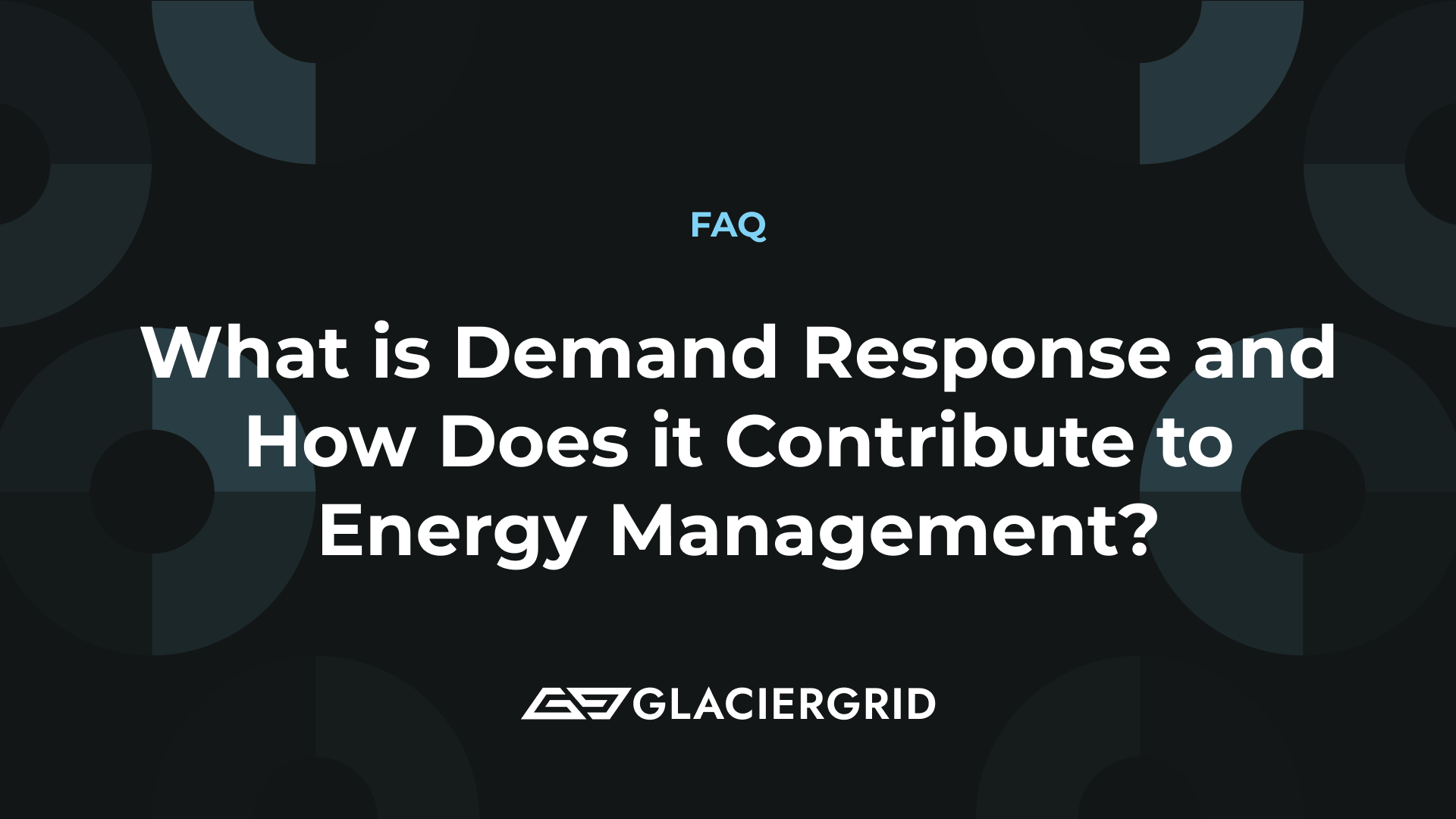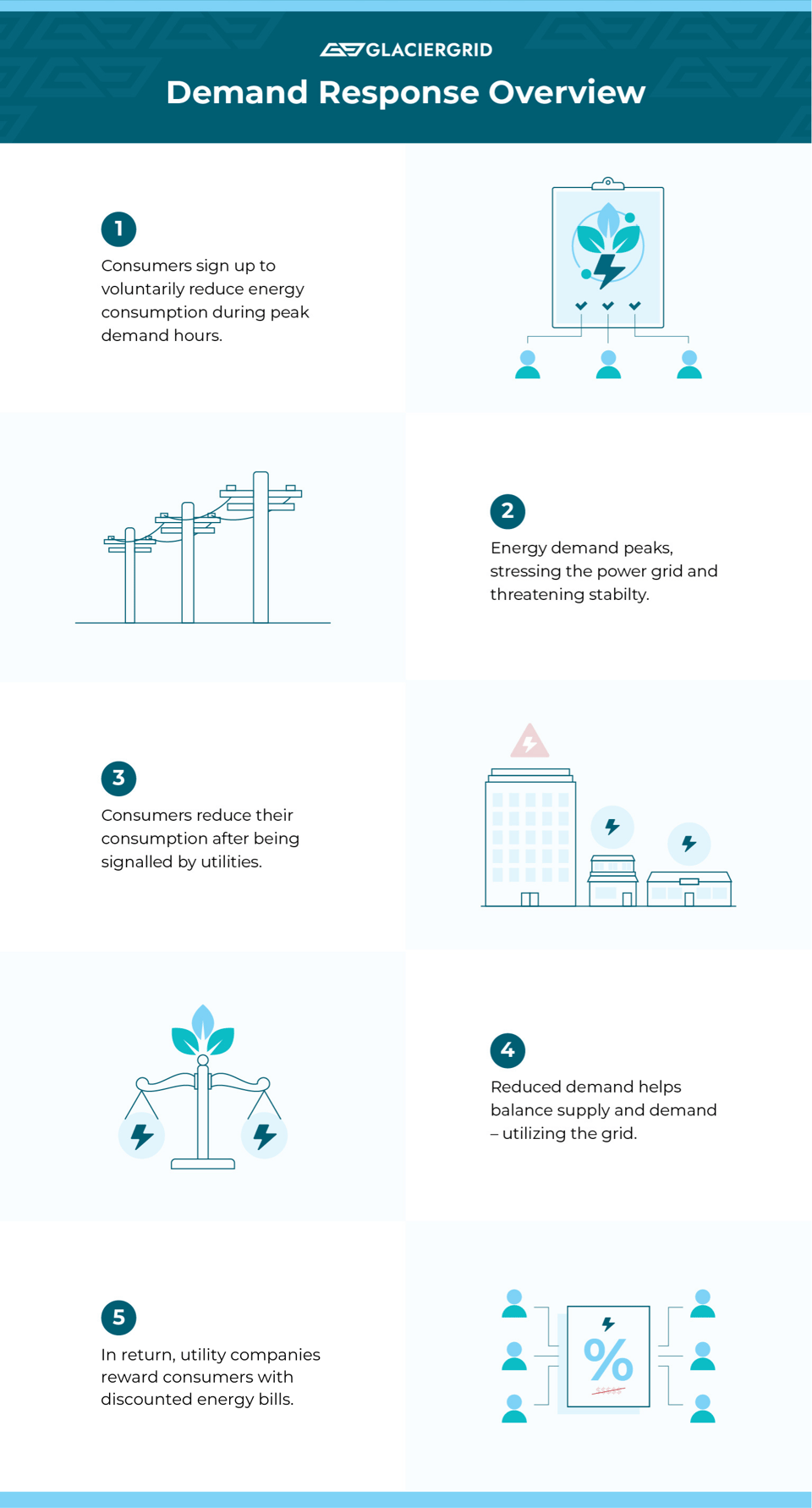What is Demand Response and How Does it Contribute to Energy Management?

Demand response addresses periods of high energy demand by reducing energy consumption. This way, the overall power grid won’t experience prolonged grid stress—which would otherwise lead to untimely power interruptions and downtimes.
The definition of Demand Response (DR)
Demand Response is reducing energy consumption during high energy demand in exchange for an incentive. This is an attempt to encourage consumers to balance the supply and demand of energy during peak demand periods or when the power demand exceeds the grid’s supply.
It’s a collaborative effort between consumers and energy providers to maintain a stable power grid—keeping the energy supply steady, reliable, and affordable.
The incentive would follow how an airline would compensate you with a free hotel room when your flight is overbooked. The airline would rather pay for your hotel room than charter a new plane.
For example:
The grid operator would rather pay you to use less rather than build a new power plant. If you can be flexible when using energy, you’ll get rewarded with discounted energy consumption costs.
There are two types of Demand Response
1. Manual Demand Response
Utility companies inform you about peak demand periods and offer incentives (financial rewards) to reduce energy use during those times.
In response, you or your staff manually adjust your energy consumption by taking any of the following actions:
- Shifting non-critical tasks to off-peak hours. For instance, pre-washing dishes or running laundry before the lunch rush.
- Temporarily reducing energy use for specific equipment. Dimming lights in the dining area or powering down unused kitchen appliances.
- Implementing alternative energy sources. Utilizing solar panels or small-scale wind turbines to offset grid reliance during peak times partially.
For example:
You, a restaurant operator, receive a notification from your utility about an upcoming peak demand period in the afternoon. You then decide to do the following in response:
- Pre-chill ingredients and prepare some dishes early in the morning when energy costs are lower.
- Dim the lights in the dining area during the peak period.
- Turn off unnecessary equipment like kitchen displays or beverage coolers.
You reduce energy demand during the peak period by taking these manual actions. In return, you earn an incentive from the utility and help stabilize the grid.
2. Automatic Demand Response
On the other hand, smart thermostats, meters, and connected equipment monitor your energy use and communicate with the utility grid.
Based on price signals or grid alerts, the system automatically adjusts your energy consumption through the following means:
- Cycling appliances on and off to spread out energy use.
- Slightly dimming lights or reducing water heater temperature.
- Drawing power from energy storage systems when grid electricity becomes costly.
For example:
A restaurant equipped with Automatic DR receives a signal about an impending demand surge from the grid. In response, the system will take the following actions:
- Automatically adjust the building's HVAC system to raise the temperature slightly in unoccupied areas.
- Dim the lights in the entrance and waiting area.
- Draws power from the building's on-site battery storage system to reduce reliance on the grid.
These automatic adjustments happen seamlessly, ensuring uninterrupted operations while reducing the building's energy demand and potentially earning DR benefits.
Which approach is right for you?
The best type of DR depends on your restaurant’s specific needs and available resources.
- Manual DR offers greater control but requires proactive effort.
- In comparison, automatic DR is convenient but may involve upfront investment in smart technology.
Ultimately, both approaches can help you manage your energy costs, contribute to grid stability, and take a step towards a more sustainable and profitable future for your food service business.
Why is DR important?
Demand Response plays a crucial role in creating a healthy balance between energy supply and demand, benefiting the energy grid and food service businesses significantly.
It paves the way for a healthy and stable energy grid
- Stability and flexibility: DR helps mitigate peak demand when everyone needs energy simultaneously. Food service businesses, known for experiencing fluctuating energy use during meal rushes, can adjust consumption during peak hours. This reduces strain on the grid, preventing blackouts and costly investments in additional power plants.
- Cost optimization: Utility companies offer financial incentives to businesses participating in DR programs. By strategically reducing energy use during peak times, food service businesses can lower their electricity bills and improve their bottom line.
- Integration of renewables: Integrating renewable energy sources like solar and wind is crucial for a sustainable future, but their output can be variable. DR helps manage this variability by adjusting demand to match available renewable energy—making the grid more reliant on clean sources.

There are two ways your business can alleviate grid stress.
It allows food service businesses to have more control over their energy use
DR empowers businesses to control their energy costs. Companies can optimize their energy consumption and gain cost predictability since they now have the capability to understand their energy usage patterns and participate in DR programs.
What are the benefits of DR for food service businesses?
The biggest and most significant benefits of DR for businesses can be categorized into three key areas: financial, operational, and reputational.
Financial benefits:
- Cost savings: As mentioned above, DR programs offer financial rewards for participating businesses. These incentives can significantly reduce energy bills, especially during peak hours—contributing to increased profitability.
- Improved energy efficiency: DR encourages businesses to optimize their energy usage by implementing smart practices and technologies. This leads to long-term energy cost reductions beyond specific DR events.
- Enhanced revenue potential: Some DR programs sell excess energy back to the grid during off-peak hours, creating an additional revenue stream for businesses.
Operational benefits:
- Increased grid resilience: Businesses participating in DR contribute to a more stable and flexible energy grid. This reduces the risk of blackouts and disruptions, ensuring less operation downtime and protecting revenue.
- Improved energy management: DR fosters a proactive approach to energy consumption. Businesses gain a deeper understanding of their energy usage patterns, allowing them to make informed decisions and optimize their energy systems.
- Competitive advantage: DR participation demonstrates a commitment to sustainability and environmental responsibility, attracting environmentally conscious customers and investors. This can lead to a differentiated brand image and a competitive edge.
Reputational benefits:
- Branding and marketing strategy: DR participation conveys a business's commitment to environmental stewardship and social responsibility. This improves brand reputation and fosters trust among customers and stakeholders.
- Compliance with regulations: DR aligns with increasing regulatory requirements for energy efficiency and reducing carbon footprint. Participation demonstrates compliance and avoids potential legal or financial penalties.
- Leadership in sustainability: Businesses actively participating in DR can become leaders in their industry regarding sustainable practices. This positions them as future-proofed and adaptable in the face of evolving energy markets and environmental concerns.

GlacierGrid can help your business comply with FDA regulations.
What is the role of DR in energy management?
Demand Response is critical in modern energy management, bridging fluctuating energy demand and limited supply.
Imagine the energy grid as a seesaw. On one side sits the energy supply generated by power plants. On the other, there’s energy demand from homes, businesses, and industries. DR helps prevent the seesaw from tilting too far in either direction through the following actions:
- Reducing demand during peak hours: When everyone demands electricity simultaneously, DR activates, encouraging consumers to shift or reduce their energy use. This happens through incentives (financial rewards), pre-arranged agreements, or automated adjustments using smart technologies.
- Increasing demand during off-peak hours: DR incentivizes consumers to use more energy when renewable sources like solar or wind produce excess energy by offering lower rates or other benefits. This helps integrate these intermittent sources into the grid more effectively.

Why is DR an opportunity for your business?
As mentioned earlier, DR is an excellent way to help your business generate more savings, streamline your operations towards efficiency, and build a positive brand image to attract today’s more environmentally-conscious customers.
DR also opens up opportunities for your business to have more control over your energy consumption—keeping your energy bills within ideal ranges.
Since DR programs promote grid stability, this also means fewer unwanted power interruptions for your business—meaning lower inventory spoilage risks.
As a bonus, DR programs also offer incentives for participating businesses. These incentives usually include utility companies giving discounts on your business’ energy consumption costs.
Overall, DR presents an opportunity for your business to improve its bottom line through smart operational optimization.
Additional resources:
For more information on demand response, you can explore the following resources:
- The State of Demand Response in 2023 by the Demand Response Institute: A comprehensive report with insights into DR trends, technologies, and challenges.
- Demand Response: A Key Enabler for the Clean Energy Transition by the IEA: Explores the potential of DR in enabling a cleaner and more resilient energy system.
- The Future of Demand Response—Trends and Opportunities by Greentech Media: Examines the evolving landscape of DR and its potential to shape future energy markets.
- 30 Must-Know Technical Terms in the Energy Management and Optimization Industry: A great reference to brush up on commonly used terms in energy management optimization operations.








